- Andrews Sisters
-
The Minnesota-born Andrews Sisters, LaVerne (1911-1967), Maxene (1916-1995) and Patty (born 1918) became a singing sensation during World War II with such hits as "Boogie Woogie Bugle Boy", "Don't Sit Under the Apple Tree", and "Beat Me Daddy, Eight to the Bar".
The sisters began singing in Vaudeville shows and other small venues until they recorded their first major hit, "Bei Mir" in 1938, which sold 350,000 copies. The Andrews Sisters reached their height of popularity in the 1940s, singing and appearing in a number of Hollywood motion pictures. As their contribution to the war effort, the girls volunteered to entertain wounded servicemen and, in 1945, went on an eight-week USO tour.
In 1954 Patty left the trio to perform solo, leaving Maxene and LaVerne as a duo act. The sisters reunited in 1956, but were unable to match their previous success in the budding age of rock 'n' roll. After LaVerne's death in 1967, Maxene and Patty followed separate career paths until 1974, when the remaining sisters teamed up to star in a short-lived broadway show, Over Here! with John Travolta and Marilu Henner.
The Andrews Sisters are pictured here with Big Band legend, Glen Miller. Photograph courtesy of Tom Rockvam & the Westonka Historical Society.
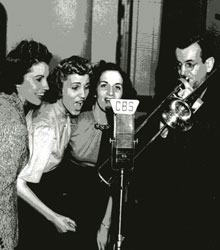
- Hope, Bob
-
Bob Hope (1903-2003), born Leslie Townes Hope, was perhaps the most popular entertainer in history to perform for U.S. Troops. He began his long career in Vaudeville, and performed on Broadway, in radio and television, and on film. His USO tours began in 1941 during World War II, and continued in times of war and peace for sixty years. In 1997, in recognition of his contributions to the military, Congress unanimously passed Resolution 75, which made Bob Hope an Honorary Veteran, the first so honored in the United States.
Photograph: Bob Hope and Cary Grant in the Army-Navy Relief Show at the Minneapolis Auditorium. Photographer: Minneapolis Star Journal, May 9, 1942. Loc. no. I.204.38.
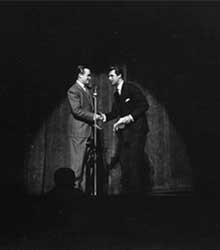
- Bradley, General Omar N.
-
General Omar Nelson Bradley (1893-1981), known as "the soldier's general" for his gentlemanly manner, served as one of the U.S.Army field commanders in the North Africa campaign and in Europe during World War II. He succeeded General Patton as head of II Corps, leading them into Sicily. He took command of the U.S. First Army for the Normandy Invasion, and planned "Operation Cobra," the breakout from the beaches of Normandy. His army bore the initial thrust in the Battle of the Bulge, and was the first to break the German defenses to cross the Rhine River in 1945.
General Bradley headed the Veterans Administration immediately after the war, was appointed Army Chief of Staff in 1948, and became the first Chairman of the Join Chiefs of Staff in 1949. He achieved the rank of five-star General of the Army in 1950. He retired from active service in 1953.
Photo: US Army; Wikipedia.org, public domain photograph

- Caruso, Enrico
-
Enrico Caruso (1873-1921) was a world-famous operatic tenor, and a pioneer of recorded music. He appeared in operas in his native Italy and in London, and was the leading male singer for the Metropolitan Opera Company in New York for 17 years. In association with the Victor Talking-Machine Company, Caruso recorded nearly 260 78-rpm records during his career. It was a mutual promotion; Caruso's popularity helped to sell Victrolas and the recordings netted the singer millions of dollars. His recording in 1902 of Vesti la giubba from Leoncavallo's Pagliacci was the first gramophone recording to sell one million copies.
Photo: Enrico Caruso, Photographer: Mishkin, 1910. MHS Photograph Collection, Loc. No. por19565 p1.
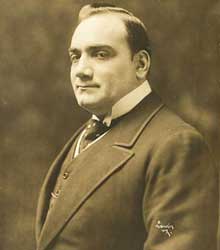
- Churchill, Winston
-
Sir Winston Leonard Spencer Churchill (1874-1965)served as British Prime Minister from 1940-1945, and again from 1951-1955. A military veteran and war correspondent in the late 19th and early 20th centuries, he an accomplished orator and statesman.
Churchill was elected to Parliament in 1900, and was named Home Secretary in 1910. He was appointed First Lord of the Admiralty in 1911, a post he held until 1915.
Winston Churchill was appointed Chancellor of the Exchequer in 1924, and continued to serve in the British government until the 1929 defeat of the Conservative government.
At the start of World War II, Churchill was again appointed First Lord of the Admiralty and became a member of the War Cabinet. He became Prime Minister upon the resignation of Neville Chamberlain in May 1940.
Photo: Winston Churchill waves to crowds in Whitehall on the day he broadcast to the nation that the war with Germany had been won. Crown Copyright; in the public domain.

- Eisenhower, General Dwight D.
-
General Dwight D. Eisenhower (1890-1969) served under illustrious Generals John J. Pershing, Douglas MacArthur, and Walter Krueger prior to World War II. He was placed in command of the Allied Forces sent to North Africa in 1942, and was named Supreme Commander of the Allied Forces in Europe for the D-Day Invasion at Normandy, a command he retained until the end of hostilities in Europe.
While serving as President of Columbia University post-war, General Eisenhower was recruited to take command of the newly formed NATO (North Atlantic Treaty Organization), international security forces in 1951.
The following year Eisenhower ran for President on the Republican ticket with the popular slogan "I like Ike," and won by a wide margin. He was elected to a second term in 1956. During his terms in office, President Eisenhower worked domestically on balancing the budget and desegregation of the South. While advocating the necessity of military strength in the United States, he focused his foreign policy on world peace.
Photo: General Dwight D. Eisenhower. MHS Photograph Collection, Loc. no. por 15450 p1.

- Erickson, Theodore A. (T.A.)
-
Theodore A. (T.A.) Erickson (1871-1963) was an instructor at the University of Minnesota's College of Agriculture. Professor Erickson recognized that rural students needed a stronger agricultural connection in education, and began the first rural boys' and girls' - later 4-H - club in Minnesota.
Photo: Theodore A. Erickson. MHS Photograph Collections, Loc. No. por 7973 r4
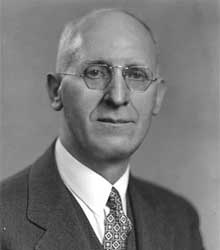
- Roosevelt, Franklin Delano
-
Franklin Delano Roosevelt (1882-1945), the 32nd President of the United States, guided the country through the Great Depression and the World War that followed. When he took office in 1933, Roosevelt was faced with bank failures, business and farm foreclosures, and record unemployment. With the declaration, "We have nothing to fear but fear itself," he immediately took steps to implement his "New Deal" policies, working with Congress to pass legislation that would provide direct relief to millions and stimulate economic recovery.
The New Deal and his courageous leadership during World War II won the president overwhelming public support. In 1940 and 1944, Roosevelt became the only American President to be elected to third and fourth terms. President Roosevelt died in office shortly before the end of World War II.Photo courtesy of the Franklin D. Roosevelt Library Digital Archives.

- Henie, Sonja
-
Sonja Henie (1912-1969) was a Norwegian-born figure skater. She won three Olympic Championships (1928, 1932, and 1936), ten World Championships (1927-1936), and six European Championships (1931-1936). Ms. Henie continued her skating career in ice shows and movies, retiring in 1958.
Photo: Governor Elmer A. Benson with Sonja Henie, 1937. MHS Photograph Collection, Location no. por 14387 p24.
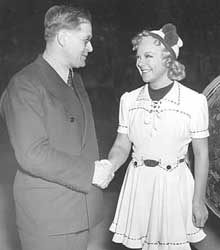
- Hitler, Adolf
-
Adolf Hitler (1889-1945) became German Chancellor in 1933, and Führer (leader) of Germany in 1934. As the charismatic leader of the National Socialist German Workers Party (Nazis), he obtained power with the lower classes through his propagandistic doctrine of nationalism, anti-Semitism, and anti-communism. Hitler aggressively sought to spread his totalitarian rule throughout Europe. His incursion into Poland in 1939 triggered World War II.
Hitler aligned himself with Italy's Fascist leader, Benito Mussolini, and later Emperor Hirohito of Japan to form a triad that became known as the Axis Powers. Together their forces occupied much of Europe and the Pacific before being brought down by the Allied nations.
As the Soviet forces marched on Berlin in late April 1945, Hitler and his wife, Eva Braun, committed suicide in his secret bunker to avoid capture by the Russians. Before his death, Hitler named Karl Dönitz as his successor.
Image: Hitler was portrayed in American wartime propaganda as a very real menace to freedom. "What do YOU say, America?" poster, 1942. Loc. no. E448.19 a13.

- von Kaltenborn, Hans
-
H.V. (Hans von) Kaltenborn (1878-1965) was a newspaperman and early radio journalist. He began his broadcasting career in 1921 with an experimental station in Newark, NJ. He worked for CBS (Columbia Broadcasting System) from 1927 to 1940. Because of his outspoken views on American intervention in the war in Europe, Kaltenborn moved to NBC (National Broadcasting Corporation) in 1940, and served as a war correspondent throughout World War II, visiting front lines in both European and Pacific theatres of operations. He continued to report the news on NBC until 1953. H.V. Kaltenborn died in 1965, and was inducted into the National Broadcasters Hall of Fame in 1977.
- King, Admiral Ernest J.
-
Admiral Ernest J. King (1878-1956), described as "intelligent and extremely capable, but controversial," served as Commander in Chief, United States Fleet and Chief of Naval Operations during World War II, the only person to have held both commands. On December 1944 he was promoted to the rank of Fleet Admiral. Admiral King received the Navy Cross and the Navy Distinguished Service Medal, among many other awards and decorations during his distinguished military career.
Photo: US Navy; Wikipedia.org, public domain photograph.

- Mussolini, Benito
-
Benito Amilcare Andrea Mussolini (1882-1945)became Prime Minister of Italy in 1922. He established a militaristic fascist dictatorship that embraced nationalism and anti-communism.
Mussolini signed a pact with Adolf Hitler in 1939 that sided Italy with Germany in World War II. Following the Allied invasion of Italy in 1943 Mussolini began to lose power. He was killed by Communist Resistance forces in an escape attempt in April, 1945.
The image: Wartime propaganda in the United States pictured the leaders of the Axis Powers as entities to be feared, as depicted by this 1942 "Careless Talk" campaign poster. "Enemy Ears are listening." MHS Poster Collection, Loc. no. E448.19 a3.
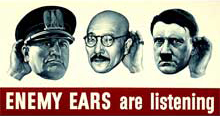
- Nimitz, Admiral Chester W.
-
Admiral Chester William Nimitz (1885-1966) served as Commander in Chief, U.S. Pacific Fleet for the United States and Allied forces (air, land and sea) during World War II. In 1944 President Roosevelt appointed Admiral Nimitz to the rank of Fleet Admiral of the United States Navy, the highest grade in the Navy.
Admiral Nimitz signed for the United States during the Japanese surrender aboard the U.S.S. Missouri on September 2, 1945.
Following his death, Admiral Nimitz was honored when the first nuclear powered super aircraft carrier, commissioned in 1975, was named for him.
Photo: US Navy; Wikipedia.org, public domain photograph.
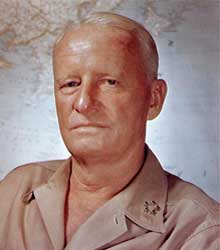
- Patton Jr. , General George S.
-
General George Smith Patton, Jr. (1885-1945) was one of the most colorful and controversial generals of World War II. He graduated from the U.S. Military Academy at West Point in 1913, and served in the newly formed United States Tank Corps in World War I.
In World War II, General Patton was a strong advocate for a U.S. armored force build-up. He led succesful missions in North Africa and Sicily, before taking command of the Third Army in France in 1944. Following the Normandy invasion, Patton's troops fought their way across Europe, pushing the German forces back and liberating concentration camps.
General Patton remained in Germany post-war, in command of the Fifteenth Army. He died of injuries sustained in a car accident on December 21, 1945, and was buried among American casualties of the Battle of the Bulge in Luxembourg.
Photo: US Army, public domain photograph

- Roosevelt, Franklin Delano
-
Franklin Delano Roosevelt (1882-1945), the 32nd President of the United States, guided the country through the Great Depression and the World War that followed. When he took office in 1933, Roosevelt was faced with bank failures, business and farm foreclosures, and record unemployment. With the declaration, "We have nothing to fear but fear itself," he immediately took steps to implement his "New Deal" policies, working with Congress to pass legislation that would provide direct relief to millions and stimulate economic recovery.
The New Deal won the president overwhelming public support. In 1940 and 1944, Roosevelt became the only American President to be elected to third and fourth terms. President Roosevelt died in office shortly before the end of World War II.Photo courtesy of the Franklin D. Roosevelt Library Digital Archives.
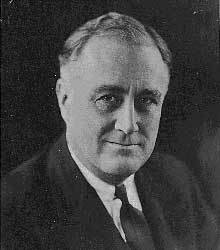
- Strauss Jr. , J.E.
-
J.E. Strauss, Jr., and his father before him, manufactured ice skates in their St. Paul, Minnesota shop throughout most of the 20th century. Their greatest innovation was the closed-toe figure skate, introduced in 1914, which featured a one-piece blade supported by three stanchions between the runner and the sole plate of the boot. The closed-toe design provided greater stability and control
Strauss skates were worn by top skaters, including Sonja Henie.
Photo: John Strauss - father and son, skate makers, 1920. Photographer: W. A. Mortenson. MHS Photograph Collection, Location no. HD4.2 r60.
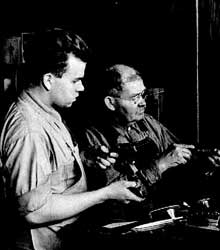
- Truman, Harry S.
-
America was stunned when President Franklin D. Roosevelt died on April 12, 1945. Many questioned whether his successor, Harry S. Truman (1884-1972) would be able to see the war to its completion.
On May 8th, less than one month after assuming office, President Truman announced the surrender of Germany to the American public: "This is a solemn but a glorious hour...General Eisenhower informs me that the forces of Germany have surrendered to the United Nations. The flags of freedom fly over all Europe."
He cautioned that the war was only half-won; that Japan still needed to be defeated. On August 6th he made the momentous decision to use the Atomic bomb on Hiroshima, followed by a second bomb dropped on Nagasaki three days later, which precipitated the end of World War II.
Harry S. Truman would go on to serve a second term in office. Some of his most notable acts as President include the desegregation of the military (Executive Order 9981, 1948), the entry of the United States in the Korean War (1950), and laid the keel of the USS Nautilus, the first atomic powered submarine.
Photo: President Truman, 1945. U.S. Army Signal Corps, courtesy Harry S. Truman Library.

MNHS openings and announcements. More details.
- Membership |
- Shop |
- Calendar |
- Donate


